- April 4, 2019
- Posted by: CoachMike
- Categories: Options Trading, Swing Trading, Trading Article
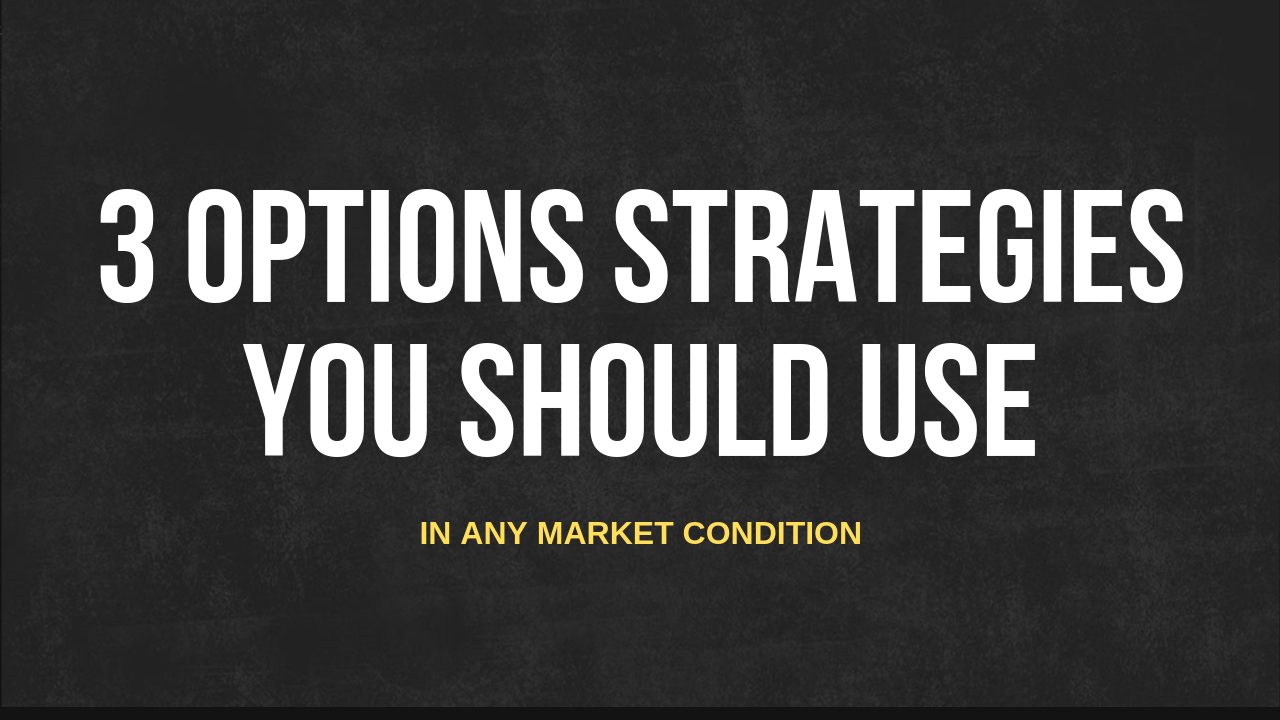
Last week, a student in our Nasdaq Options Superstars program had a hard time grasping why anyone would consider other options strategies.
“If I’m bullish it’s best to buy calls. If bearish it’s best to just buy puts.”
While most people get attracted to the idea of trading options because of the big profit potential of long calls and puts, trading them exclusively can lead to very inconsistent results.
Yes, buying call and put options is a viable strategy as long as it’s just one tool in your options toolbox. When the market is making moves back and forth in both directions they can produce really impressive growth in your account.
Forcing the long call and put strategies to work in all market conditions is a mistake.
There are times of the year where markets don’t do much so you must ensure you are picking the right strategy at the right time.
The summer months for example, tend to be very slow and choppy in many cases. Trading around the holidays at the end of the year can also produce very uncertain market conditions.
During these times it will be best to have other strategies to go to which will produce more consistent returns. This is where the vertical spreads come into play.
Vertical Spreads During Uncertain Market Conditions
To show how useful the vertical spreads can be, let’s walk through an example of how to put on a bearish trade using 3 different options strategies. This will give us the opportunity to show the pros and cons of each approach and talk about when it’s best to use each strategy.
For this, example we will be taking a look at EBAY.
At the time of this article, we are looking to place a bearish trade with the price of the stock at $39.78. Let’s take a look at the different ways we can structure the trade.
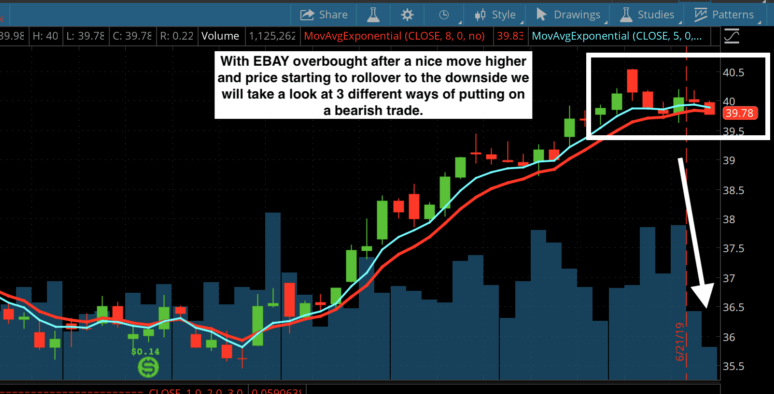
Trade #1 – Long Put
The most aggressive trade that we can take when looking for a bearish position is buying the 19 Jul 19 – 41 put option for $1.91 or $191 per contract.
These are the July monthly options with 25 days left to expiration.
We would use the monthly options at this point because we are heading into the summer months where trades can take longer to complete.
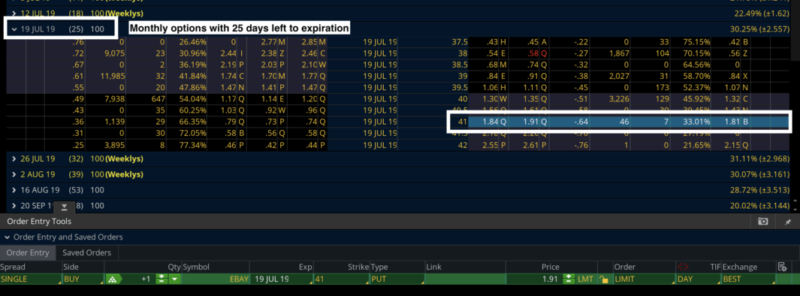
The moment we buy a long put position the time decay is working against us, meaning we are paying a premium every day that we hold the trade.
By going out to the monthly options instead of the weekly options, we are able to limit the impact of the time decay slightly.
Should we decide to buy the 41 put options for $1.91 or $191 per contract, that $191 is the most we can lose.
We have an unlimited profit potential on the trade.
As long as the price of the stock continues moving lower the put option will continue to increase in value.

The problem with the long put is that it only has one way of making money for us.
The price of the stock has to move lower and it has to do so quickly.
If it takes too long, we will end up losing money on the trade or not make as much money as we hope to.
The long put will always give us the biggest profit potential but it also comes with the most risk. If you decide to use the long put you need to have a strong opinion that a big move lower is coming quickly. There are times when this could be the best strategy.
However, what other ways do we have of being a little more conservative?
Trade #2 – Long Put Spread
Looking at the chart of EBAY, let’s say we still wanted to lean bearish but what if we don’t feel comfortable risking $191 per contract like we talked about when buying the long put?
What if we weren’t expecting a quick move lower?
Another options strategy that we can use to lower the risk of the trade and leave us with a more conservative position is to buy the put vertical spread.
Buying a put spread is still a bearish position.
It is initiated by buying the 19 Jul 19 40.5 put and selling the 38 put at the same time.
By buying an option and selling another option at the same time we are able to reduce the cost of the trade from $191 per contract down to $103 per spread.
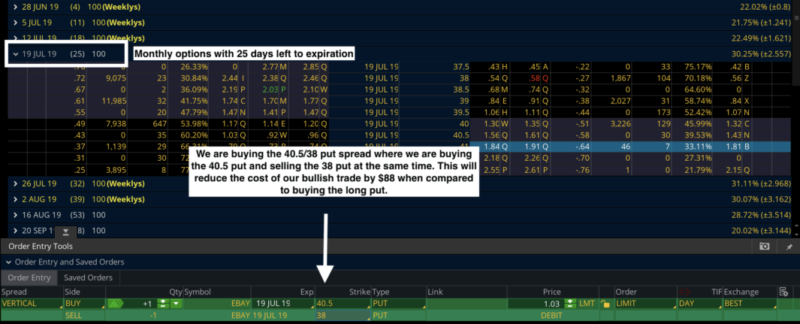
This gives us an $88 cost savings by placing the spread.
It also leaves us with a position that has a lower profit potential.
Instead of making money as long as EBAY moves lower, we cap our profit potential once EBAY moves below $38 per share (the price of the put option that we are selling).

This is an ideal trade to use when you have a directional opinion on a stock but you are uncertain on the timing of the trade.
We like to structure our long vertical spreads by:
- buying the option that is 1 strike in the money at the time of the trade and then
- sell the option with the strike as close to the target price that we expect the stock to go to.
Using this criteria will allow us to see a 30-50% cost savings when comparing it to the long put.
It still leaves us with a risk defined trade. We can’t lose more than what we pay for the spread. The 30-50% cost savings can open the door for you to trade the higher priced stocks without a large account size.
While the profit potential will be lower, the long put spread is a great way to lean bearish with a fraction of the risk.
Trade #3 – Short Call Spread
There are times throughout the year when the market gets really slow.
We could see a tight sideways move in price action or see the moves take much longer than what we see in active markets.
As a result, we might not want to buy a long put or a put spread like we talked about earlier as both of those trade types have time decay working against us. We are paying a small premium every day to hold those long options.
One way to stack the deck in our favor during these slow markets is to sell a credit spread.
In our EBAY example we are looking for a bearish position. A third way of getting that bearish position is to sell a call spread.
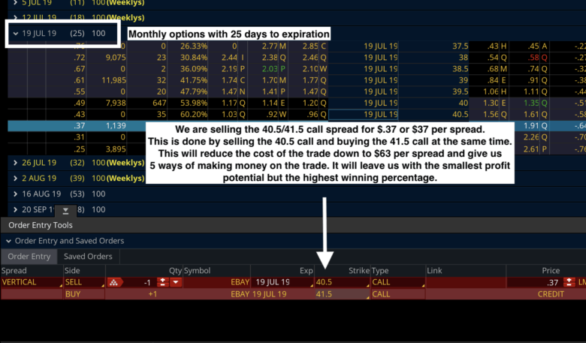
We can still use the 19 Jul 19 monthly options with 25 days left to expiration.
For this trade, we are going to sell the 40.5 call and buy the 41.5 call at the same time. In doing so, we are able to collect $.37 or $37 per spread.
This $37 is the most money we can make on the trade regardless of what the price of EBAY stock does.
Most people get intimidated by credit spreads because they think they come with a large amount of risk.
In this example, our risk is limited to $63 per spread.
This max risk is calculated by taking the difference between the strike prices ($1 difference between the 40.5 and 41.5 options) and subtracting the $.37 that we are collecting to put the trade on.
This is the most we can lose on the trade even if we are dead wrong and EBAY moves higher from here.

The break even point on this trade would be at $40.87. This number is calculated by taking the strike price of the option that we are selling (40.5) and adding on the $.37 that are collecting for putting the trade on.
We don’t care if the stock price moves up, down, or sideways as long as price stays below $40.87 we can make money.
We also make money from time decay adding up.
Every day that passes actually helps us make money on the trade which is completely opposite of the long put and long put spread trades that we talked about earlier.
Finally, we also make money from volatility decreasing during the trade.
If volatility decreases it will cause the options to decrease in value faster. That is exactly what we want to have happen as we make money on this trade as the options get cheaper.
This gives us 5 different ways of making money on the trade.
It will leave us with a position that has the lowest profit potential of the three trade types but will give us the highest probability of success. These are great trade types to use when you want a conservative position that will make money even in a slower market environment.
Which Options Trade Do You Use?
Now that we have taken a look at 3 different ways of putting on a bearish trade on EBAY the question becomes which one is best?
The answer to that question depends on your outlook for the stock.
There is no right or wrong answer.
Ideally, I like to have a mix of these trade types in my portfolio. Each one does something different for me. Using all 3 will allow us to layer in more diversification which will lead to more consistent growth in our account.
- The long put option will give us the highest profit potential but with the most risk.
- The long put spread will lower the profit potential but also lower the risk by 30-50%.
- The short call spread will give us the lowest profit potential but will also give us the highest probability of success.
Once you start mixing up these three trade types you will see far better results from your trading.
Don’t lock yourself into the high risk/high reward long calls and puts exclusively as the market might not be moving enough to allow those trades to work. Using vertical spreads as well will allow you to focus on taking what the market is giving you.
Would You Like our 6 Best Options Secrets & Strategies to Grow Your Account? This is a free guide that will help you take your options trading to a whole other level. The link is below this article.
Now is a perfect time to take your options trading to the next level. Don’t miss out on these great trade types that will unlock the power of options trading like you have never seen before.
3 Comments
Comments are closed.

Thanks
Thank you for your very informative menu of topics which I found to ve very easy to understand and definitely useful. Thanks for the free access to your quality educational resources which is a rare thing nowdays
Thanks for the feedback. Feel free to reach out with any questions that we can help with going forward.